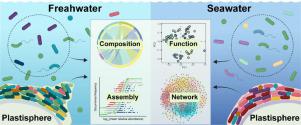Water Research ( IF 11.4 ) Pub Date : 2021-07-15 , DOI: 10.1016/j.watres.2021.117428 Changchao Li 1 , Lifei Wang 1 , Shuping Ji 1 , Mengjie Chang 1 , Longfei Wang 2 , Yandong Gan 3 , Jian Liu 1

|
Microplastics provide a unique habitat for microorganisms, forming the plastisphere. Yet the ecology of the plastisphere, including the microbial composition, functions, assembly processes, and interaction networks, needs to be understood. Here, we collected microplastics and their surrounding water samples in freshwater and seawater ecosystems. The bacterial and fungal communities of the plastisphere and the aquatic environment were studied based on 16S and internal transcribed spacer (ITS) high-throughput sequencing. We found that the plastisphere had a distinct microbial community and recruited a noteworthy proportion of unique species compared to the aquatic environment community, potentially altering ecosystem microbial community and causing microbial invasion. Using a random-forest machine-learning model, we identified a group of biomarkers that could best distinguish the plastisphere from the aquatic environment. Significant differences exist in microbial functions between the plastisphere and the aquatic environment, including functions of pathogenicity, compound degradation, as well as functions related to the cycling of carbon, nitrogen, and sulfur. And these functional differences were expressed differently in freshwater and seawater ecosystems. The oxidation-reduction potential, salinity, the concentrations of nitrogen-related ions (NO3−, NO2−, and NH4+), and the concentration of dissolved organic carbon in the surrounding environment drive the variation of the plastisphere. But environmental physicochemical properties explain less of the microbial community variation in the plastisphere than that in the aquatic environment. Niche-based processes govern the assembly of the plastisphere community, while neutral-based processes dominate the community assembly of the aquatic environment. Furthermore, compared to the aquatic environment, the plastisphere has a network of less complexity, more modules, higher modularity, and more competitive links in freshwater ecosystems, but the pattern is reversed in seawater ecosystems. Altogether, the microbial ecology of the new anthropogenic ecosystem—plastisphere—is unique and exerts different effects in freshwater and seawater ecosystems.
中文翻译:

塑料圈的生态学:淡水和海水生态系统中的微生物组成、功能、组装和网络
微塑料为微生物提供了独特的栖息地,形成了塑料圈。然而,需要了解塑料圈的生态学,包括微生物组成、功能、组装过程和相互作用网络。在这里,我们在淡水和海水生态系统中收集了微塑料及其周围的水样。基于 16S 和内部转录间隔 (ITS) 高通量测序研究了塑料圈和水生环境的细菌和真菌群落。我们发现,与水生环境群落相比,塑料圈具有独特的微生物群落,并招募了显着比例的独特物种,这可能会改变生态系统微生物群落并导致微生物入侵。使用随机森林机器学习模型,我们确定了一组最能区分塑料圈和水生环境的生物标志物。塑料圈和水生环境之间的微生物功能存在显着差异,包括致病功能、化合物降解功能以及与碳、氮和硫循环相关的功能。并且这些功能差异在淡水和海水生态系统中表现不同。氧化还原电位、盐度、氮相关离子(NO 和硫磺。并且这些功能差异在淡水和海水生态系统中表现不同。氧化还原电位、盐度、氮相关离子(NO 和硫磺。并且这些功能差异在淡水和海水生态系统中表现不同。氧化还原电位、盐度、氮相关离子(NO3 -、NO 2 -和 NH 4 +),以及周围环境中溶解有机碳的浓度驱动了塑性层的变化。但是,与水生环境相比,环境物理化学特性对塑料圈中微生物群落变异的解释较少。基于生态位的过程控制着塑料圈群落的组装,而基于中性的过程控制着水生环境的群落组装。此外,与水生环境相比,塑料圈在淡水生态系统中具有复杂性较低、模块更多、模块性更高、竞争性更强的网络,但在海水生态系统中则相反。总之,新的人为生态系统——塑料圈——的微生物生态是独一无二的,对淡水和海水生态系统产生不同的影响。











































 京公网安备 11010802027423号
京公网安备 11010802027423号